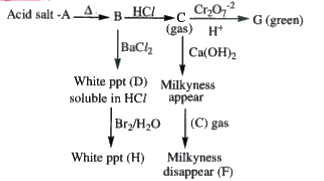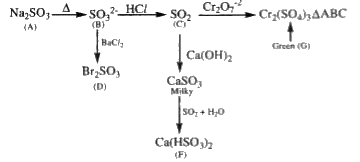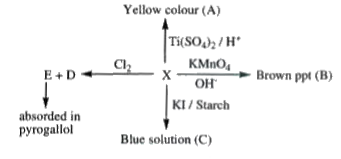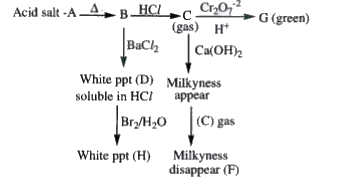Passage-II:

'G' is Solution in Telugu
CrO−24
Cr+3
CrO5
CrO3
The correct Answer is:B

∴C=SO2,D=BaSO4,G=Cr2(SO4)3(or)Cr+3
Topper's Solved these Questions
- BOOK - AAKASH SERIESCHAPTER - VIA GROUP ELEMENTSEXERCISE - PRACTICE SHEET - 5 (Match the following questions)2videos
VIA GROUP ELEMENTS
- BOOK - AAKASH SERIESCHAPTER - VIA GROUP ELEMENTSEXERCISE - PRACTICE SHEET - 5 ( Integer answer type Questions)6videos
VIA GROUP ELEMENTS
- BOOK - AAKASH SERIESCHAPTER - VIA GROUP ELEMENTSEXERCISE - PRACTICE SHEET - 4 (Integer answer type Questions)2videos
VIA GROUP ELEMENTS
- BOOK - AAKASH SERIESCHAPTER - VA GROUP ELEMENTSEXERCISE - PRACTICE EXERCISE51videos
VA GROUP ELEMENTS
- BOOK - AAKASH SERIESCHAPTER - VII GROUP ELEMENTSEXERCISE - OBJECTIVE EXERCISE -455videos
VII GROUP ELEMENTS
Similar Questions
COLUMN-ICOLUMN-II(A)Na2S2O3(p)NaCl(B)Na2S2O3+AgNO3(q)Na3[Ag(S2O3)2](C)Na2S2O3+Cl2+H2O(r)Na2SO4(D)Na2S2O3+I2(s)Na2S4O6
03:57View SolutionWhen This sulphate ion is oxidized by iodinc, new product 'X' is formed. The number of s-s linkage isi/are present in 'X'?
04:15View SolutionSulphuric acid acts as a powerful dehydrating agent. How many no of carbons are formed when glucose molecule is dehydratred by H2SO4 as reagent
04:13View SolutionWhich of the following reacts rapidly with oxygen in the air at ordinary temperature?
07:25View Solution(A): The bond dissociation energy of fluorine is less than bromine.
(R): In fluorine molecule, large lone pair electronic repulsions and appreciable internuclear repulsions are present.03:10View SolutionWater can be decomposed by the passage on an electric current according to the following equation:
2H2O(l)→2H2(g)+O2(g)
How many "mole"s of H2(g) can be produced from the passage of 4.8×1021 electrons?03:51View SolutionThe passage of current through a solution of certain electrolyte results in the evolution of H2(g) at cathode and Cl2(g) at anode. The electrolytic solution is :
03:17View Solutionनिम्न तीन अभिक्रियाओं (II,II,III) के लिए, साम्य स्थिरांक दिए गए है
(I) CO(g)+H2O(g)⇔CO2(g)+H2(g),K1
(II) CH4(g)+H2O(g)⇔CO(g)+3H2(g),K2
(III) CH4(g)+2H2O(g)⇔CO2(g)+4H2(g),K3
निम्न में से कौन-सा सम्बन्ध सत्य है02:37View Solutionनिम्नलिखित तीन अभिक्रियाओं I, II और III के लिए साम्यावस्था स्थिरांक दिए गए हैं:
1. CO(g)+H2O(g)<⇒CO2(g)+H2(g),K1
2.CH4(g)+H2O(g)<⇒CO(g)+3H2(g),K2
3. CH4(g)+2H2O(g)<⇒CO2(g)+4H2(g),K3
निम्नलिखित में से कौनसा संबंध सही है?02:20View SolutionPassage - V: Reaction, C to G is
06:12View SolutionPassage - II :

The oxidation state of 'Mn' in 'B' isView SolutionPassage - II :

During its reaction with Cl2, 'X' acts as03:25View SolutionPassage-II:

'C' is04:53View SolutionPassage-II: 'D' is
02:16View SolutionThe passage of current through a solution of certain electrolyte results in the evolution of H2(g) at cathode and Cl2(g) at anode. The electrolytic solution is :
View Solution

